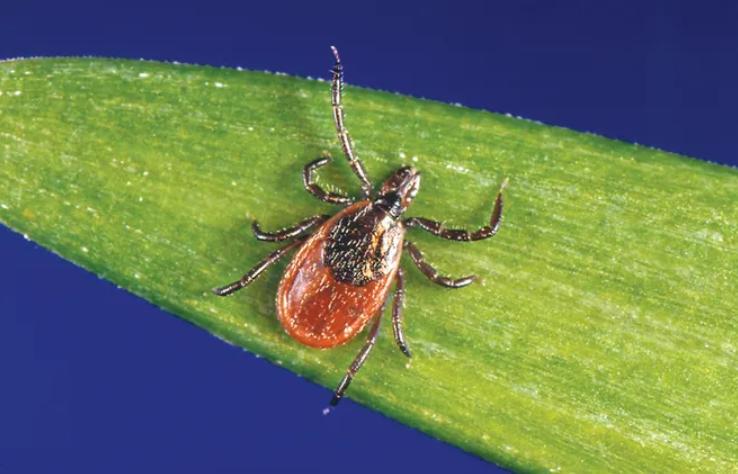Do regular tick checks: Seacoast doctors share tips to avoid ticks and Lyme disease

PORTSMOUTH — Tick season is here and a little caution and doctors say common sense can help you avoid serious diseases like Lyme, anaplasmosis and babesiosis.
"This is definitely the right time for ticks," said Dr. Gretchen Volpe, an infectious disease expert at York Hospital. "There are a number of diseases associated with ticks, so the best advice is prevention."
A tick doesn’t hurt when it bites, and deer ticks are so tiny that they can go unnoticed on the body until they become engorged, or never be noticed at all — unless the host develops Lyme symptoms.

“The classic Lyme disease symptom is an expanding, flat rash that often looks like a bullseye,” said Jeffrey Parsonnet, MD, a physician in Infectious Disease and International Health for Dartmouth Health. “Other symptoms are flu-like — aches, stiffness, fatigue — and might develop five to seven days after receiving a bite. More advanced disease might cause swollen joints, infection of nerves responsible for heart rhythm regulation, or neurologic disorders like Bell’s palsy (partial face paralysis), pain in limbs or, rarely, brain infection.”
More: Clear Choice MD urgent care coming to Rochester in old Friendly's location
"Ticks are definitely something to be concerned about," said Dr. Brendan Murphy, a family practitioner at Wentworth-Douglass Hospital. "We are talking about the black-legged tick, also called a deer tick. They circulate primarily in the nymph state so they are very small and often difficult to see."

Murphy said New Hampshire has one of the higher incidences of Lyme disease in the country so residents here should be extra vigilant. Gov. Chris Sununu declared May to be Lyme Disease Awareness Month in the state.
Lyme disease is well-known for being associated with tick bites. Lesser known diseases also associated with ticks are anaplasmosis and babesiosis. All three have similar symptoms, flu-like including fever, headache, body aches and rashes.
Volpe said that there are diagnostic tests for Lyme disease, but early tests often offer a false negative.
More: Baby formula shortage: What Seacoast parents need to know, from local experts.
"So if Lyme is suspected, doctors will begin treatment with oral antibiotics," she said. "Better to do that than to wait for a more clear test. More severe cases could require IV antibiotic treatments. Even if you find a tick up to 36 hours, I would advise to still talk with your doctor."
"It can be weeks before there is a positive Lyme test," said Murphy. "So it makes sense to treat if there is a suspicion that there was a tick bite."
Murphy said doxycycline is the most common antibiotic treatment.
"People prescribed this should be aware that it will make people very sensitive to sunlight," he said.
How to spot a rash
Lyme disease is associated with a bull's-eye rash, but Murphy said not always.
"Sometimes the rash is not that easily defined," he said. "But do not ignore a rash, particularly if there are other symptoms."
Volpe said anaplasmosis and babesiosis require lab testing to diagnose
All three diseases are treated using a course of antibiotics.
More: 'A game changer.' New 988 number to connect those in mental health crisis with instant help
Volpe talked about the commonly known steps for avoiding ticks and had a really good idea that she shares with her patients.
It is fairly common knowledge by now that a tick bite is usually not serious if it is discovered and removed within 36 hours.
"I tell people, especially if they are outside a lot, themselves or with their pets, to do tick checks every 24 hours," said Volpe. "Check yourself for ticks; check hidden areas like armpits, behind the knees. If you find a tick and know it is less than 36 hours, the worry is significantly less likely that it has attached sufficiently to transmit disease."
Murphy said to use an insect repellent that contains DEET.
"Treat your pets for ticks and fleas," he said. "Many times ticks will come in the house on the dog, so be sure you do tick checks for them, too."
Other precautions Volpe recommends include making sure your skin is covered when out walking in woods or high grass.
While Lyme disease can be very serious, it can be prevented and treated. Parsonnet offers the following tips for keeping ticks at bay so you and your family can enjoy New England’s beautiful summer season:
Stay covered. Prevention begins with keeping ticks off of your body. Wear long pants, socks and long sleeves when outdoors, and insect repellents containing DEET are highly effective.
More: People are not a disease: Why language on mental health, substance use matters
Ticks can attach anywhere, so check your entire body and your children's bodies as well. If you do find a tick, remove it with a pair of tweezers, trying to remove as much as possible, but the body will naturally reject bits left behind.
There are times when a patient doesn’t find a tick and never develops the tell-tale rash but experiences other Lyme disease symptoms.
“In those cases, many physicians will treat for Lyme disease with a 14- to 21-day course of antibiotics,” said Parsonnet. “There is a diagnostic blood test for Lyme, but it only turns positive a month or so after infection so it's not a useful test in the acute setting."
This summer might be a good one for ticks, but it doesn’t have to be a bad one for people. “Remember to cover up, check for ticks and remove them immediately,” Parsonnet said. “And, if you do get Lyme disease, treatment is highly effective at preventing late complications.”
This article originally appeared on Fosters Daily Democrat: May is Lyme Disease Awareness Month in NH, tips about ticks

